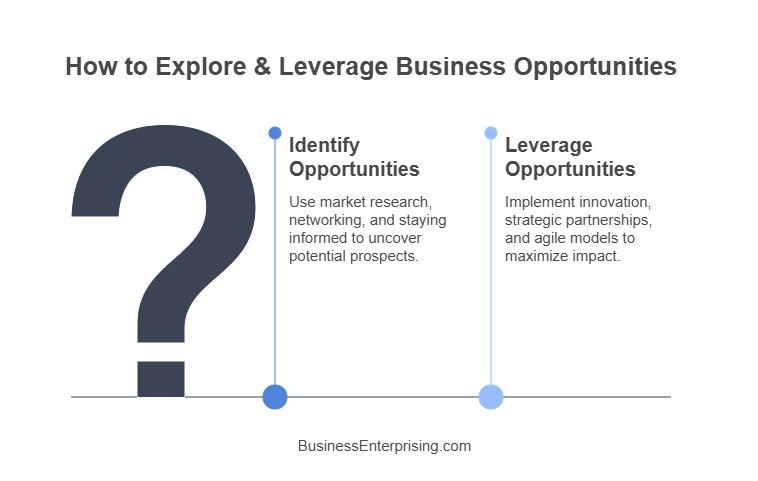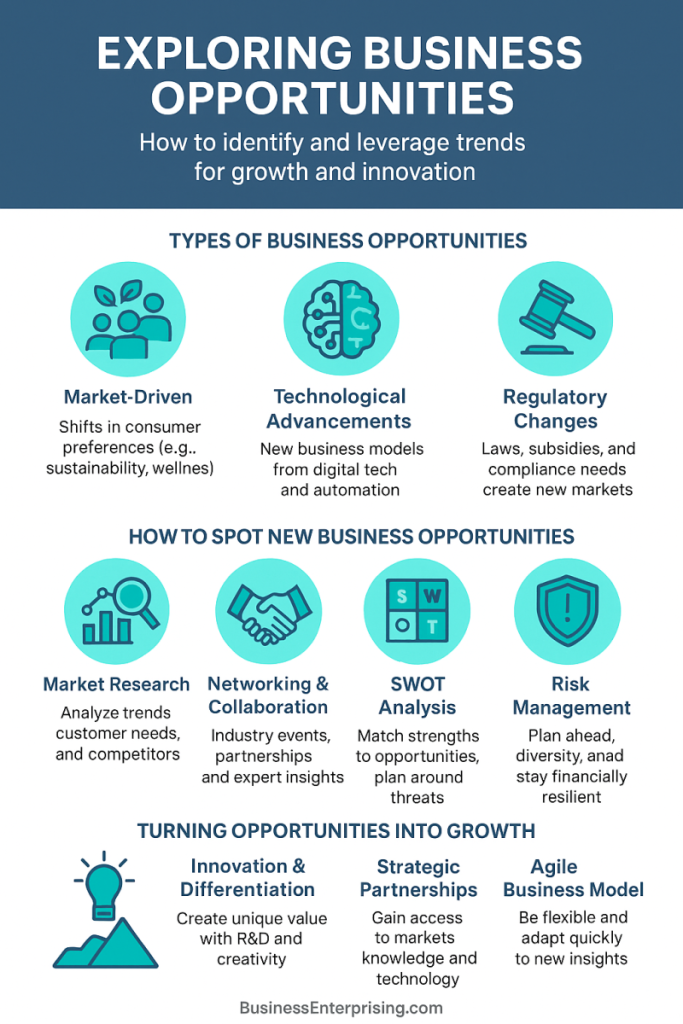
Types of Business Opportunities
To begin with, it’s important to understand the different types of business opportunities available. These can generally be categorized into three broad groups: market-driven opportunities, technological advancements, and regulatory changes.
Market-Driven Opportunities
Firstly, market-driven opportunities arise from shifts in consumer behavior, preferences, and demographics. For instance, the increasing demand for sustainable products has opened up avenues for businesses to develop eco-friendly goods and services. Similarly, the growing health consciousness among consumers presents opportunities in the wellness and fitness sectors.
Technological Advancements
Secondly, technological advancements offer a plethora of opportunities. The rise of digital technology, artificial intelligence, and automation has revolutionized various industries, creating new business models and disrupting traditional ones. For example, the advent of e-commerce has transformed retail, while advancements in fintech are reshaping the financial services landscape.
Regulatory Changes
Lastly, regulatory changes can also create business opportunities. New laws and regulations often necessitate compliance, leading to demand for specialized services. Additionally, government incentives and subsidies for certain industries can stimulate growth and attract investment. For example, policies promoting renewable energy have spurred innovation and investment in the clean energy sector.
Identifying Business Opportunities
Identifying business opportunities requires a combination of market research, trend analysis, and strategic foresight. Here are some effective methods to uncover promising prospects:
Market Research
Firstly, conducting thorough market research is crucial. This involves analyzing market trends, customer needs, and competitive landscapes. Surveys, focus groups, and data analytics can provide valuable insights into consumer behavior and preferences. Moreover, monitoring industry reports and market forecasts can help identify emerging trends and potential gaps in the market.
Networking and Collaboration
Secondly, networking and collaboration play a significant role in exploring business opportunities. Attending industry conferences, trade shows, and networking events allows entrepreneurs to connect with peers, industry experts, and potential partners. These interactions can lead to valuable insights, collaborations, and the discovery of new opportunities.
Staying Informed
Thirdly, staying informed about technological advancements and regulatory changes is essential. Subscribing to industry publications, following thought leaders on social media, and participating in relevant online communities can keep entrepreneurs updated on the latest developments. Additionally, engaging with academic research and participating in professional development programs can provide deeper insights into industry trends and innovations.
SWOT Analysis
Furthermore, conducting a SWOT analysis (Strengths, Weaknesses, Opportunities, Threats) can help identify opportunities that align with a business’s core competencies. By evaluating internal strengths and weaknesses alongside external opportunities and threats, businesses can strategically position themselves to capitalize on favorable conditions.
Leveraging Business Opportunities
Once identified, effectively leveraging business opportunities requires strategic planning and execution. Here are some key strategies to consider:
Innovation and Differentiation
Firstly, innovation and differentiation are critical. Businesses must continually innovate to stay ahead of the competition. This involves developing unique products or services that address unmet needs or offer superior value. Investing in research and development, fostering a culture of creativity, and leveraging emerging technologies can drive innovation and differentiation.
Strategic Partnerships
Secondly, forming strategic partnerships can enhance the ability to capitalize on opportunities. Collaborating with other businesses, research institutions, or industry experts can provide access to new markets, technologies, and resources. Strategic alliances can also facilitate knowledge sharing and innovation, leading to mutually beneficial outcomes.
Agile Business Model
Thirdly, adopting an agile business model is essential for responding to opportunities quickly. This involves being flexible and adaptive, ready to pivot or iterate based on market feedback. Implementing agile methodologies in project management and fostering a responsive organizational culture can enhance the ability to seize opportunities as they arise.
Market Penetration and Expansion
Additionally, market penetration and expansion strategies can help maximize the impact of identified opportunities. This may involve targeting new customer segments, entering new geographic markets, or diversifying product offerings. Effective market penetration requires a deep understanding of customer needs and preferences, along with targeted marketing and sales efforts.
Risk Management
Moreover, managing risk is a crucial aspect of leveraging business opportunities. Every opportunity comes with inherent risks, and it’s important to assess and mitigate these risks through comprehensive planning and analysis. Developing contingency plans, diversifying investments, and maintaining financial resilience can help navigate uncertainties and ensure long-term success.
Conclusion
In conclusion, exploring business opportunities is vital for growth and sustainability in today’s dynamic market. By understanding the different types of opportunities, employing effective identification methods, and strategically leveraging them, you can stay ahead of the curve and drive success. As the business landscape continues to evolve, staying vigilant, adaptable, and innovative will be key to unlocking new opportunities and achieving long-term prosperity. Entrepreneurs and business owners must embrace a proactive approach, continuously seeking and seizing opportunities to build a thriving and resilient enterprise.


